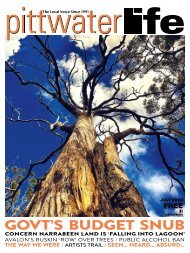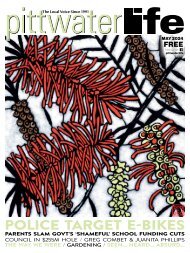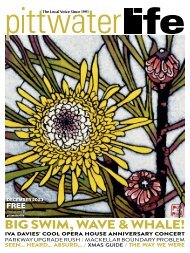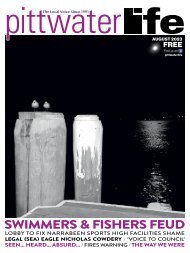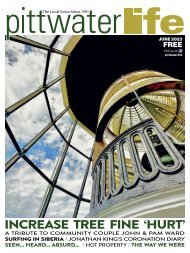Pittwater Life April 2017 Issue
Arrested Development. Straight Shooter. Help To "Shape 2028". ANZAC Day. Avalon Surf Swap. Easter Activities.
Arrested Development. Straight Shooter. Help To "Shape 2028". ANZAC Day. Avalon Surf Swap. Easter Activities.
Create successful ePaper yourself
Turn your PDF publications into a flip-book with our unique Google optimized e-Paper software.
Health & Wellbeing<br />
Health & Wellbeing<br />
What to do when breast<br />
size causes discomfort<br />
Nowadays breast<br />
reductions are<br />
commonly performed,<br />
with generally very favourable<br />
results.<br />
It’s a fact that larger breasts<br />
may contribute to poor<br />
posture, shoulder, neck and<br />
back pain, rashes under the<br />
breasts and may also limit<br />
exercise. Bra selection may<br />
also be difficult and cause<br />
grooving on the shoulders.<br />
Reducing the size and weight<br />
of breasts may improve these<br />
conditions – although it<br />
cannot be guaranteed.<br />
There are many techniques<br />
of breast reduction. These are<br />
selected by assessing breast<br />
and chest parameters, size of<br />
reduction and scar tendency.<br />
Mastopexy, or breast lift,<br />
is a very similar procedure.<br />
In breast lift, the remaining<br />
breast tissue is rearranged to<br />
create a breast cone. Skin is<br />
removed and then redraped.<br />
With breast reduction, both<br />
skin and breast tissue are<br />
removed and the remaining<br />
breast tissue used to create a<br />
breast cone to allow closure.<br />
Larger breasts may also be<br />
associated with a degree of<br />
droop. The nipple position<br />
is determined by using three<br />
parameters: the position of<br />
the infra-mammary fold (the<br />
fold where breast meets chest<br />
wall) projected forwards; the<br />
midpoint of the humerus or<br />
arm bone; and a set distance<br />
from either the midpoint of<br />
the collar-bone or the base of<br />
the neck. This distance varies<br />
with the height of the person.<br />
Once the correct position has<br />
been established, a keyhole<br />
shape pattern is drawn around<br />
this point. Depending on the<br />
width of the lines and the<br />
length determines the amount<br />
of reduction.<br />
Breasts that are unequal or<br />
asymmetrical can be made to<br />
be more equal.<br />
A common misconception is<br />
that the nipple is removed and<br />
replaced. This is usually not<br />
the case. The nipple is kept on<br />
a pedicle of tissue. This allows<br />
inflow of blood and nerve<br />
supply, keeping the nipple<br />
alive and sensate. By keeping<br />
continuity with the nipple<br />
and the breast ducts, breast<br />
feeding may be possible.<br />
Surgery is performed under<br />
general anaesthetic. Local<br />
anaesthetic may also be used<br />
to minimise bleeding and<br />
bruising and reducing the<br />
amount of general anaesthetic<br />
required. The use of drains<br />
or drainage tubes depends<br />
on the surgeon. Surgeons<br />
will also decide on the length<br />
of hospital stay – usually<br />
overnight only. Smaller<br />
reductions may be performed<br />
as day surgery.<br />
The tendency is now<br />
to reduce the amount of<br />
scarring. This is usually the<br />
horizontal portion of the<br />
anchor-shaped scar that may<br />
already be hidden in the<br />
infra-mammary fold. There<br />
is a visible scar around the<br />
areolar and a vertical scar<br />
downwards from the areolar<br />
to the infra-mammary fold.<br />
Larger areolar are usually<br />
reduced. Liposuction of the<br />
lateral parts, under the arm,<br />
may be combined as this<br />
reduces tissue in this area,<br />
the axillary tail, and does<br />
not introduce more scarring.<br />
Scar management, or looking<br />
after the scar, is important.<br />
Each surgeon will guide you<br />
through this to try to optimise<br />
the final scar.<br />
The excised tissue is<br />
with Dr John Kippen<br />
weighed to try to get breasts<br />
as equal as possible but<br />
there will always be minor<br />
differences in size, shape<br />
and projection. Bra size is<br />
used as a guide only, as cup<br />
size varies with different bra<br />
manufacturers. Any tissue<br />
that is removed is sent for<br />
histological examination to<br />
exclude breast cancer or other<br />
breast disease. Benign cysts<br />
are a common finding at the<br />
time of surgery.<br />
Many women tolerate<br />
this procedure very well<br />
and are happy with the<br />
results. As always, careful<br />
consultation with your<br />
surgeon optimises realistic<br />
expectations and ensures a<br />
thorough understanding of<br />
the procedure and steps to full<br />
recovery.<br />
Our columnist Dr John<br />
Kippen is a qualified, fully<br />
certified consultant specialist<br />
in Cosmetic, Plastic and<br />
Reconstructive surgery.<br />
Australian trained, he also<br />
has additional Australian and<br />
International Fellowships.<br />
Dr Kippen works from custom-built<br />
premises in Mona<br />
Vale. He welcomes enquiries<br />
and questions. Please<br />
contact him via johnkippen.<br />
com.au or by email: doctor@<br />
johnkippen.com.au<br />
42 APRIL <strong>2017</strong><br />
Celebrating 25 Years



